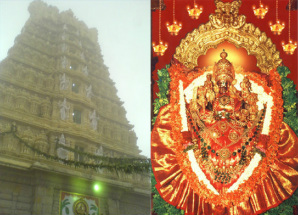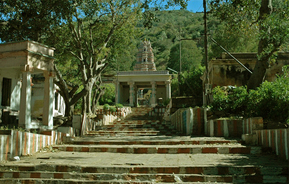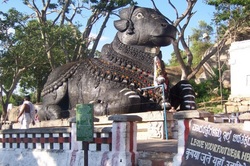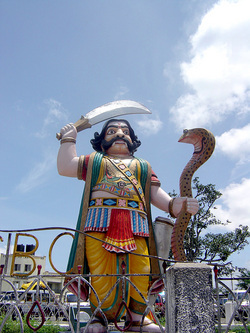Chamundi Hills

The Chamundi Hills are located in India, close to the palace city of Mysore. Its average elevation is 1,000 meters.
According to legend, the demon Mahishasura, king of the area that is currently Mysore, was killed by the Goddess Chamundeswari (also Chamundi) after a fierce battle. The hills are named after the goddess, and a temple honors her in the hills. The temple has a beautiful idol of the goddess. The temple has always been patronised by the rulers of Mysore. In earlier days, the Maharajas of Mysore would ride the ceremonial Dasara elephant during the annual Dasara festival; since the seventies, the idol of Goddess Chamundi is taken on an elephant.
A panoramic view of the city is seen from the top of the hills. Among other landmarks, you can see the race course, the Lalitha Mahal palace, Mysore Palace, Karanji and Kukkarahalli lakes.
There a long stairway leading to the top of the hill. There are 1,180 steps in all, and climbing the first 600 steps takes some effort. En route to the top, the steps pass the large monolithic statue of Nandi the Bull. Nandi is the vahana (Vehicle) of Lord Shiva. Climbing gets easier thereafter.
There are regular buses plying to the Chamundi hills from the central bus stand.
The top of the hill has a few attractions - the Mahishasura Statue, the Chamundeswari Temple, and a few other temples nearby. The Rajendra Vilas palace used to be a popular hotel earlier, but is now closed to the public. The palace is now being redone and provides a panoramic view of Chamundi Hill, Chamundi Temple and the city of Mysore.
According to legend, the demon Mahishasura, king of the area that is currently Mysore, was killed by the Goddess Chamundeswari (also Chamundi) after a fierce battle. The hills are named after the goddess, and a temple honors her in the hills. The temple has a beautiful idol of the goddess. The temple has always been patronised by the rulers of Mysore. In earlier days, the Maharajas of Mysore would ride the ceremonial Dasara elephant during the annual Dasara festival; since the seventies, the idol of Goddess Chamundi is taken on an elephant.
A panoramic view of the city is seen from the top of the hills. Among other landmarks, you can see the race course, the Lalitha Mahal palace, Mysore Palace, Karanji and Kukkarahalli lakes.
There a long stairway leading to the top of the hill. There are 1,180 steps in all, and climbing the first 600 steps takes some effort. En route to the top, the steps pass the large monolithic statue of Nandi the Bull. Nandi is the vahana (Vehicle) of Lord Shiva. Climbing gets easier thereafter.
There are regular buses plying to the Chamundi hills from the central bus stand.
The top of the hill has a few attractions - the Mahishasura Statue, the Chamundeswari Temple, and a few other temples nearby. The Rajendra Vilas palace used to be a popular hotel earlier, but is now closed to the public. The palace is now being redone and provides a panoramic view of Chamundi Hill, Chamundi Temple and the city of Mysore.
Climbing Chamundi Hills

Climbing the steps of Chamundi Hills is a popular way of keeping fit among the locals in Mysore. The main set of 1000 steps takes anywhere between 12 to 30 minutes to climb depending on an individual's fitness levels and provides an excellent way to increase cardio vascular fitness. Some individuals climb only till the Nandi which is about 700 steps, then run on the downhill road to the other side of Chamundi hills for about 2 Kilometers and climb another set of 600 steps to the top. This set of steps at the back of the hill is not very well known but provide an excellent challenge for fitness. Groups of youngsters also tend to trek through the jungle and thickets of the Chamundi Hill Slopes to the top. This has reduced in recent years due to stories of leopards residing on the jungle slopes. Sometimes leopards have been sighted near the roads during late evenings leading to the top and have been photographed providing a sense of additional thrill to people who seek adventure walking up the slopes.
Nandi the Bull

Two highly regarded Hindu points of interest call Chamundi Hill home . The first, Sri Chamundeswari Temple, sits atop the summit some 3000 feet high overlooking the hazy skies of Mysore, Karnataka. While the second, a monolith statue of Nandi the Bull, lies nestled in the hillside foliage.
Depictions of Nandi the bull, Lord Shiva’s vehicle, can be found throughout South India. But the carving here on Chamundi Hill, from 1659, minutes from Mysore, is particularly noteworthy. Purists and pilgrims access the monolith via the famous and well documented steps leading from the hill’s base to the summit. These steps, also added in 1659, number between 1000 and 1500 depending on which route a person travels. A second more isolated set of steps exist on the hill’s opposite side which are reportedly more interesting and preferred by locals, regardless of the rumored leopards which roam the brush.
Nandi sits 15 feet high, 24 feet in width and is carved out of a single piece of rock, thus making it a monolith. Easily accessed either by road or steps, tourists can stop by for a photo opp with the statue crouching on a cement base surrounded by a black, rod iron gate. An arti plate sits in front of the bull as a self-service blessing for followers who perform puja.
Depictions of Nandi the bull, Lord Shiva’s vehicle, can be found throughout South India. But the carving here on Chamundi Hill, from 1659, minutes from Mysore, is particularly noteworthy. Purists and pilgrims access the monolith via the famous and well documented steps leading from the hill’s base to the summit. These steps, also added in 1659, number between 1000 and 1500 depending on which route a person travels. A second more isolated set of steps exist on the hill’s opposite side which are reportedly more interesting and preferred by locals, regardless of the rumored leopards which roam the brush.
Nandi sits 15 feet high, 24 feet in width and is carved out of a single piece of rock, thus making it a monolith. Easily accessed either by road or steps, tourists can stop by for a photo opp with the statue crouching on a cement base surrounded by a black, rod iron gate. An arti plate sits in front of the bull as a self-service blessing for followers who perform puja.
Mahishasura

Mahishasura the demon was born as a union of Rambha and a she buffalo (Mahishi) and consequently was a half man and half buffalo. The mighty demon was rendered more powerful as a result of a boon from God Agni, according to which he could be killed by a woman only. He managed to wreak havoc in heaven by chasing away all Gods from there. All the Gods then approached lord Vishnu and lord Shiva who were aware that only a woman could kill Mahishasura. They decided to create a Goddess out of the collective powers or 'Tejas' of all the God's and so was born a Goddess who combined in herself all that was mighty and powerful in each God. She was armed by a trident from Shiva, Chakra from Vishnu, a Lion from Himalayas and bows and arrows from Vayu. The Goddess filled with combined power and anger of all the Gods was fierce to behold and her very sight scared the demons.
Mahishasura on the other hand, waged a valiant fight against her and assumed the form of a buffalo, a lion, a man carrying a sword, an elephant and lastly again as a buffalo. The battle raged for ten thousand years and finally the Goddess was able to pin down Mahishasura and chop off his head. The Gods, rid of the demon, showered the Goddess with innumerable praises and with reverence prayed her to appear every time they were in need of her. Granting the same to the Gods, she disappeared to appear again when called with devotion.
